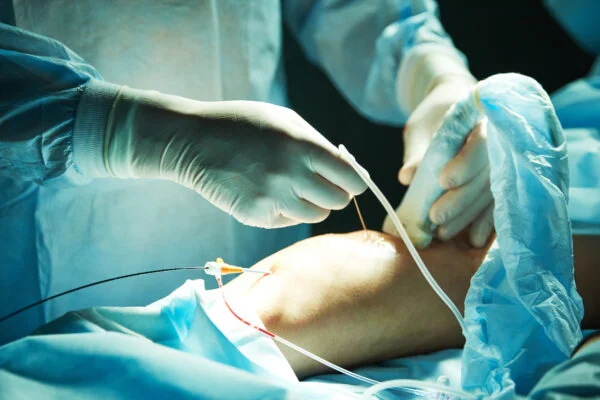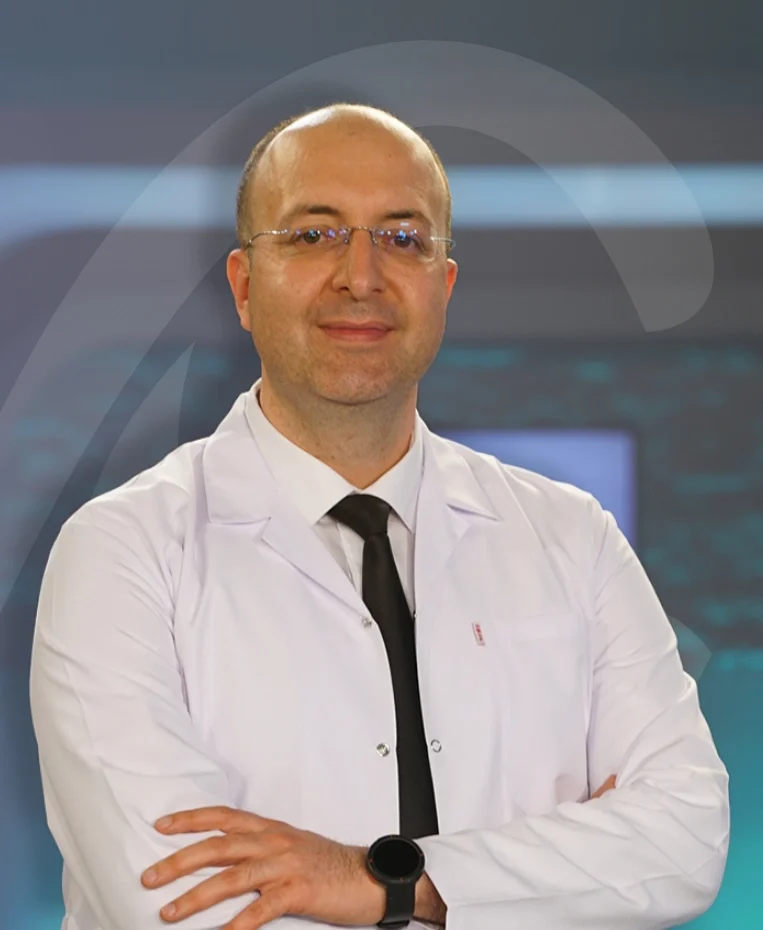Endovenous Laser RF Ablation


Endovenous laser and RFA are minimally invasive treatments aimed at closing malfunctioning main veins, such as the saphenous vein, in cases of chronic venous insufficiency. Laser or radiofrequency energy is applied inside the vein to heat and close the vein wall in a controlled manner. This eliminates reflux and reduces varicose vein symptoms.
Laser and radiofrequency ablation techniques offer less pain, faster recovery, and better aesthetic results compared to open surgery. The procedure is performed under local anesthesia with ultrasound guidance. Once the vein is closed, blood flow is redirected through healthy veins, maintaining circulatory balance.
Advantages of endovenous ablation include a low complication rate, short recovery period, and rapid return to daily life. Patients are usually discharged the same day. The use of compression stockings after the procedure supports the permanence of vein closure and reduces potential swelling.
Follow-up with Doppler ultrasound is used to evaluate vein closure success. Regular check-ups are important to prevent new reflux. Endovenous laser or RF ablation performed by an experienced physician with appropriate patient selection offers high success rates in treating venous insufficiency.

Veins are the system that carries blood back from the legs to the heart. Inside these veins are one-way “valves” that prevent blood from flowing backward due to gravity. Chronic venous insufficiency, or varicose veins, begins when these valves fail.
When the valves fail to function properly, blood cannot be efficiently pumped toward the heart and instead flows backward into the legs (known as “venous reflux”). This leads to blood pooling inside the veins, creating an abnormal pressure increase called “venous hypertension.” This elevated pressure causes the veins to dilate, twist, and become visible under the skin.
Absolutely not. Varicose veins are not only an aesthetic concern but a progressive health problem if left untreated. Although it may start with mild symptoms, the underlying venous hypertension causes the condition to worsen over time. In advanced stages (according to the CEAP classification), serious complications can develop.
Early symptoms usually include:
If left untreated, this condition can progress to:
Until recently, the only standard treatment for saphenous vein insufficiency was surgery. In the method known as “high ligation and stripping,” the vein was tied off at the groin and then pulled out of the body with a wire called a “stripper.”
This procedure required general or spinal anesthesia, involved incisions, and led to hospital stays, postoperative pain, bruising, and a long recovery period—typical of traditional surgery.
Over the past two decades, endovenous treatments such as Laser (EVLA) and Radiofrequency (RFA) have largely replaced traditional surgery. International guidelines (European and American Venous Societies) now recommend these minimally invasive methods as first-line treatments over surgery.
The reason for this shift is simple: unlike conventional surgery, endovenous ablation does not require general anesthesia, large incisions, or stitches. The procedure is performed through a tiny needle puncture. Patients can walk immediately afterward, return home the same day, and resume normal activities within just a few days. Postoperative pain and bruising are minimal compared to surgery.
Radiofrequency ablation (often performed with the ClosureFast system) can be thought of as a “heat sealing iron” that closes the vein wall in a controlled way.
During the procedure, a thin catheter is inserted into the vein under ultrasound guidance. The tip of this catheter contains a heating element that produces radiofrequency energy. This element comes into direct contact with the vein wall and heats it to approximately 120°C in precisely controlled 20-second cycles.
This controlled heat causes the collagen fibers in the vein wall to contract instantly, making the vein walls stick together and close. The catheter is gradually withdrawn in segments along the vein, closing the entire diseased section in a controlled manner.
Laser ablation works differently—more like a “steam generator.”
In this method, instead of a catheter, a thin laser fiber is inserted into the vein. When activated, the laser fiber tip reaches extremely high temperatures exceeding 1000°C (unlike RFA’s 120°C).
The key mechanism is the indirect transfer of heat to the vein wall. The laser light instantly vaporizes the small amount of blood and tumescent fluid remaining inside the vein, creating “steam bubbles.” These hot vapor bubbles, together with the heated tip of the fiber, contact the vein wall, causing closure through conduction and convection heating.
In the past, laser treatment was known to cause more pain and bruising compared to RFA, due to the use of old “bare-tip” fibers. These older fibers projected energy forward like a flashlight, sometimes penetrating the vein wall and damaging surrounding tissues.
Modern EVLA technology has solved these issues through two major advancements:
Thanks to these improvements (1470 nm + Radial Fiber), modern EVLA now offers comfort levels comparable to RFA.
Patient selection is based on a detailed physical examination and, most importantly, Color Doppler Ultrasound (DUS) performed in a standing position.
Ideal candidates for EVLA or RFA are patients with symptoms related to varicose veins (pain, swelling, cramps, etc.) and ultrasound findings of reflux in main superficial veins such as the Great Saphenous Vein (GSV) or Small Saphenous Vein (SSV).
These treatments can safely be applied to a wide range of patients—from those with mild varicose veins (CEAP C2) to those with swelling (C3), skin changes (C4), or even active ulcers (C6).
EVLA or RFA may not be appropriate in the following cases (contraindications):
If the deep venous system is blocked and the treated superficial vein serves as a bypass, ablation is contraindicated. Patients with coagulation disorders or who are immobile (bedridden) also require careful evaluation.
Tumescent anesthesia (TA) is a crucial step for ensuring both the safety and effectiveness of EVLA and RFA treatments.
It consists of a very dilute mixture of local anesthetic (usually lidocaine) and saline. During the procedure, large amounts of this fluid are injected—under ultrasound guidance—around the vein to be treated.
Tumescent anesthesia not only prevents pain but also serves as a “safety cushion” with three vital functions:
Thermal ablation (EVLA or RFA) typically follows these steps:
Long-term data show that both thermal methods provide excellent and durable outcomes. Large clinical studies report closure rates exceeding 93–95% at one year for both RFA and EVLA. Even at five years, ClosureFast RFA maintains a 91.9% closure rate, comparable to modern EVLA.
Studies have also shown that after five years, modern EVLA, RFA, and traditional stripping surgery yield similar outcomes in vein closure and quality-of-life improvement.
This means all current treatments are considered durable. The deciding factor today is no longer “Does it work long-term?”—since they all do—but rather which offers the best short-term comfort and safety for the patient.
This has been one of the most debated topics in the literature. In older studies—especially when “bare-tip” lasers were used—it was clear that RFA caused less pain and bruising than EVLA.
However, with the introduction of 1470 nm wavelength and Radial Fiber technology (modern EVLA), this difference has almost disappeared. Contemporary head-to-head studies show no significant difference between RFA and modern EVLA in terms of pain scores, patient satisfaction, or return-to-activity time. In clinical practice, both are very well tolerated and minimally painful procedures.
EVLA and RFA are extremely safe procedures. The most common side effects are mild and temporary, including minor pain, tenderness, tightness, and slight bruising along the treated vein.
However, since heat is involved, there are two specific complications worth noting:
Nerve Injury (Paresthesia):
This is the main safety difference between the two technologies. RFA’s controlled 120°C heat is more easily contained by the tumescent anesthesia shield. In contrast, EVLA’s 1000°C+ “steam bubble” mechanism creates a slightly larger “thermal blast radius,” posing a higher risk of minor nerve irritation, particularly below the knee.
Meta-analyses confirm that EVLA carries a statistically higher risk of transient paresthesia compared to RFA. This usually presents as numbness, tingling, or mild sensory loss and typically resolves over time.
Endovenous Heat-Induced Thrombosis (EHIT):
This thermal ablation–specific complication can occur within the first week after treatment. It is defined as limited thrombus (clot) extension from the treated superficial vein into the adjacent deep vein (groin or behind the knee).
Not all EHITs are clinically significant. The AVF/SVS classification standardizes management:
The main purpose of the routine ultrasound check (within 72 hours to 1 week post-procedure) is to detect and treat asymptomatic Class III/IV EHIT cases.
Recovery after endovenous ablation is much faster than surgery. To maintain treatment success and prevent complications, patients should follow these key rules:
Yes. In recent years, “Non-Thermal, Non-Tumescent” (NTNT) techniques have been developed to eliminate the disadvantages of thermal methods (EVLA/RFA).
The most popular among these is Cyanocrylate Closure (CAC; VenaSeal), also known as the “glue” method.
This technique closes the vein by injecting medical-grade cyanoacrylate adhesive (“medical superglue”) rather than by heating it.
VenaSeal advantages over thermal methods include:
There is no single “best” treatment—only the one most suitable for you. Modern treatments (RFA, modern EVLA, and even surgery) all offer excellent long-term success rates.
Here’s how they compare:
The final decision should be made jointly between the patient and physician, based on vein anatomy (diameter, depth), patient preferences (e.g., avoiding needles or stockings), and the doctor’s experience with each technology.
Endovenous Laser or RF Ablation is mainly used to treat varicose veins and superficial venous insufficiency in the legs. It closes the enlarged vein internally, allowing blood to circulate through healthy veins.
Recovery is generally fast; most patients can walk the same day and return to normal activities within a few days. Mild bruising or tightness may occur but usually subsides quickly.
It may not be suitable for patients with deep vein thrombosis, severe arterial blockage, or advanced circulatory disorders. The procedure is also postponed for pregnant women and those with active infections.
Because it is performed under local anesthesia, patients feel no significant pain. They may only sense mild warmth or pressure, followed by minor temporary discomfort or sensitivity.
As a minimally invasive method, it requires no surgical incision. The results are more aesthetic, recovery is faster, and recurrence rates are lower than traditional varicose surgery. There are no major anesthesia risks, and bleeding or infection risk is minimal.
The treated vein does not reopen, but new varicose veins may develop in different areas. Regular follow-ups and lifestyle adjustments help minimize recurrence.
Patients should wear compression stockings, walk regularly, and avoid prolonged standing. Hot baths should also be avoided for the first few weeks.
In traditional surgery, the vein is completely removed, while in endovenous ablation, it is closed internally. Therefore, bruising, pain, and scarring are significantly less after ablation.
Office workers usually return to work within 1–2 days, while those with physically demanding jobs may need 4–5 days. Early mobility is a major advantage of this treatment.
Heavy exercise should be avoided during the first week. Light activities such as walking are encouraged. Running, swimming, and cycling can usually be resumed safely after 7–14 days.